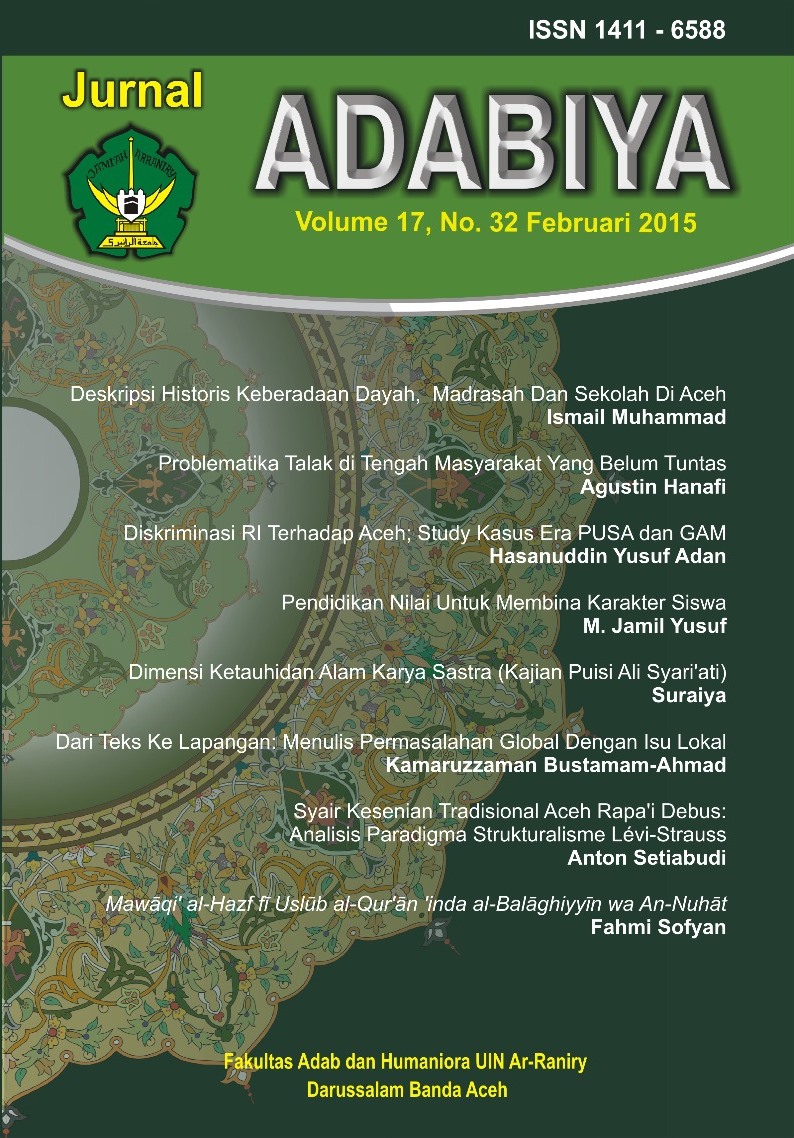Tradisi Berburu Rusa Dalam Masyarakat Kluet: Kajian Etnografi Di Kecamatan Kluet Tengah
DOI:
https://doi.org/10.22373/adabiya.v19i2.7511Keywords:
Tradition, deer hunting, deer handlerAbstract
The tradition of deer hunting is an activity undertaken to catch deer using dog help, followed by many people and led by the handler. This paper is the result of a study that explores in depth the procession of deer hunting tradition, the meaning contained in deer hunting, and the public’s view of deer hunting activities in Kluet Tengah District. This research is a qualitative research and data collection technique is done through observation and interviews of key infomation which know about deer hunting tradition, such as deer handler, customary figures, adat leaders, community leaders, and experienced people and directly involved in the implementation deer hunting traditions, and literature studies. The results show that the hunting tradition is still frequently performed by the Kluet community, especially in the wake of the commemoration of the big days that will be carried out by the community. Hunting tradition also has taboos that must be obeyed by hunting members to avoid misfortune or misfortune. According to society’s perception, deer animals have guards in the form of spirits who have the power to wound anyone who harassed his home and animals. For this reason, before a hunting activity, the handler must perform several stages and ritual processes to ask not to be disturbed and given his animal. The process of burning keminjon, preparing tools, searching for perjak, seeking bekih, and profit sharing. The results of deer hunting are always shared with all the people present during the division process, although he did not participate in the huntReferences
A. Hasjmy, Sejarah Masuk dan Berkembangnya Islam, Jakarta, Bulan Bintang, 1985.
Aka Kamarul Zaman, M. Dahlan Y. Al Barry, Kamus Ilmiah Serapan Disertai Tambahan dan Pedoman Umum Pembentukan Istilah, Jogyakarta: Jogyakarta Absolut, 2005.
Bogok Suyanto, Metode Penelitian Sosial; Berbagai Alternatif Pendekatan, Jakarta, Kencana, 2008.
Badan Pusat Statistik, Kluet Tengah Dalam Angka 2013, Badan Pusat Statistik Kabupaten Aceh Selatan, 2012.
Badruzzaman Ismail, Sistem Budaya Adat Aceh Dalam Membangun Kesejahteraan, Banda Aceh: Majelis Adat Aceh, 2008.
Bukhari RA, dkk, Kluet Dalam Bayang- Bayang Sejarah, Banda Aceh,
Team Ikatan Kekeluargaan Masyarakat Kluet, 2008.
C. Snouck Hurgronje, Gayo Masyarakat dan Kebudayaannya Awal Abad Ke 20. Terj.
Hatta Hasan Aman Ansyah, Jakarta: Balai Pustaka, 1996.
Damaring Tyas wulandari, dkk, E, Ensyclopedia Fauna, Jakarta: Erlangga, 2008.
Em Zul Fajri, Ratu Afrilia Senja, Kamus Lengkap Bahasa Indonesia, Jakarta: Aneka Ilmu Dan Difa publisher,2008.
Firkawin Zuska, Dkk, Kearifan Lokal Masyarakat simalungun, Banda Aceh:
BPNB Banda Aceh, 2012.
H. Mahmud Ibrahim, Hakim Aman Pinan, Syari’at dan Adad Istiadad, Aceh Tengah: Yayasan Maqamam Mahmuda Takengon, 2005.
IAIN Ar-Raniry dan Biro Keistimewaan Aceh Propinsi NAD, Kelembagaan Adat Propinsi Nanggroe Aceh Darussalam, Banda Aceh: Ar- Raniry Press, 2006.
Jabaruddin Manik, Skripsi: Pengaruh Budaya Temetok Terhadap Kehidupan Soial Masyarakat, Studi Kasus Di Kecamatan Gunung Meriah Kabupaten Singgkil, Banda Aceh: Fakultas Adab dan Humaniora,2013.
Lexy J. Moleong, Metodelogi Penelitian Kualitatif, Bandung: PT Remaja
Rosdakarya, 2007.
L Suharsimi Arikunto, Prosedur Penelitian: Suatu Pendekatan Praktek, Edisi Revisi V,Jakarta: Rineka Cipta, 2002.
L.K.Ara Medri, Ensiklopedi Aceh, Banda Aceh: Badan Arsip Dan Kepustakaan NAD, 2008.
L.K. Ara, Ensiklopedi Aceh(Musik, Tari, Teater, Seni Rupa), Banda Aceh: Yayasan Mata Air Jernih, Badan Arsip dan Pustaka Aceh, CV
Tati Group Banda Aceh, 2009.
Muhammad Umar, Perdaban Aceh(Tamaddun) I, Banda Aceh: Yayasan BUSAFAT, 2006.
Mundardjito, dkk, Sejarah Kebudayaan Indonesia-Sistem Teknologi,Jakarta: PT. Raja Grafindo Persada, 2009.
Tim Pustaka Poenix, Kamus Besar Bahasa Indonesia Edisi Baru, Jakarta: Pustaka Poenix, 2007.
Sugiyono, Metode Penelitian Kuantitatif, Kualitatif dan Research & Devolement, Bandung: Alfabeta, 2006.
Willian A. Haviland, R.G. Soekadijo, Antropologi Jilid 2, Surakarta: Erlangga, 1985.
Willian A. Haviland, R.G. Soekadijo, Antropologi Jilid 1, Surakarta: Erlangga, 1985.
Sember Internet http://nasional. kompas. com/
read/2012/02/06/10545040/ Dari.
Salmon. Asap. hingga. www.Papuaweb.org/unipa/dlib-s123/
chahya-dwi/s1.pdf
http://yayasaniarindonesia.blogspot. com/2011/07/undang-undangpemerintah-untuk.html
Downloads
Published
Issue
Section
License
Procedure Proposed for Public Access Journals The authors of Jurnal Adabiya Journal adhere to the following terms:
a. Authors retain copyright and grant the journal the right of first publication, with the work licensed under a Creative Commons Attribution-ShareAlike 4.0 International License that permits others to share the work with attribution to the authorship and first publication in this journal.
b. Authors may enter into separate, additional contractual arrangements for the non-exclusive distribution of the journal's published version of the work (such as posting it to an institutional repository or publishing it in a book), with attribution to the journal's initial publication.
c. Authors are permitted and encouraged to submit their work online (e.g., in institutional repositories or on their website) before and during the submission process, as this can lead to fruitful exchanges and increased citations of published work (See The Effect of Open Access).
d. Jurnal Adabiya Journal publishes, distributes, uses, and repurposes scholarly works under the CC-BY SA license or an equivalent license.

